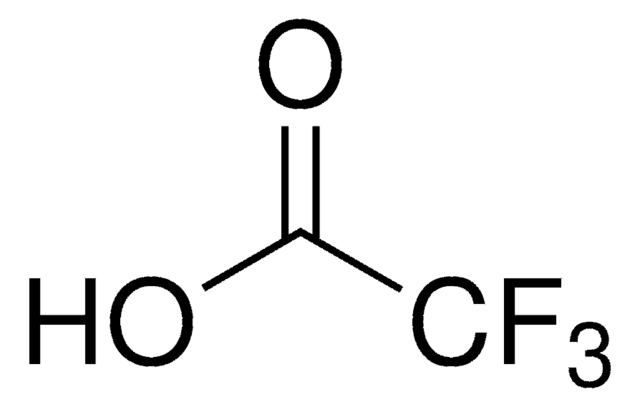F0507
Ameisensäure
reagent grade, ≥95%
About This Item
Empfohlene Produkte
Qualität
reagent grade
Qualitätsniveau
Dampfdichte
1.6 (vs air)
Dampfdruck
44.8 mmHg ( 20 °C)
Assay
≥95%
Form
liquid
Selbstzündungstemp.
1004 °F
Enthält
<2.5% water as stabilizer
Expl.-Gr.
57 %
Verunreinigungen
≤1% acetic acid
Brechungsindex
n20/D 1.370 (lit.)
pH-Wert
2.2 (20 °C, 2.2 g/L)
bp
100-101 °C (lit.)
mp (Schmelzpunkt)
8.2-8.4 °C (lit.)
Dichte
1.22 g/mL at 25 °C (lit.)
Lagertemp.
room temp
SMILES String
OC=O
InChI
1S/CH2O2/c2-1-3/h1H,(H,2,3)
InChIKey
BDAGIHXWWSANSR-UHFFFAOYSA-N
Suchen Sie nach ähnlichen Produkten? Aufrufen Leitfaden zum Produktvergleich
Allgemeine Beschreibung
Anwendung
- Elektrochemische CO(2)-Reduktion auf metallischem und oxidiertem Zinn: In dieser Studie werden die großkanonische Dichtefunktionaltheorie (DFT) und die in situ abgeschwächte Totalreflexionsspektroskopie mit oberflächenverstärkter Infrarotabsorption (ATR-SEIRA) verwendet, um die elektrochemische Kohlendioxidreduktion auf Zinnoberflächen zu untersuchen, wobei Ameisensäure eine Rolle für das Verständnis der Reaktionsmechanismen spielen könnte (Whittaker et al., 2024).
- Simultaneous Measurement of COVID-19 Treatment Drugs: Diese Forschungsarbeit zeigt die Verwendung von UPLC-MS/MS für die gleichzeitige Messung von COVID-19-Medikamenten in Rattenplasma, was die Bedeutung von Ameisensäure bei der Probenvorbereitung oder als Additiv der mobilen Phase für eine bessere chromatographische Trennung belegt (Zhou et al., 2024).
- Profilerstellung der Metaboliten von Liquiritin: Die Studie umfasst Metaboliten-Profiling mittels Ultrahochleistungsflüssigchromatographie mit Tandem-Massenspektrometrie (UHPLC-MS/MS), bei der Ameisensäure wahrscheinlich in der Probenvorbereitung oder bei chromatographischen Prozessen verwendet wird (Chen et al., 2024).
- Analyse von Kokain und seinen Metaboliten: In diesem Artikel wird die Festphasenextraktion mit anschließender UHPLC-ESI-MS/MS-Analyse von Kokainmetaboliten untersucht, einer Methode, die häufig Ameisensäure zur Verstärkung der Ionisierung von Analyten einbezieht (Makhdoom et al., 2024).
- Bestimmung von antimikrobiellen Verbindungen in Schweinen: In dieser Forschungsarbeit wird UHPLC-MS/MS für die gleichzeitige Bestimmung verschiedener antimikrobieller Verbindungen verwendet, was die Rolle von Ameisensäure bei der Probenverarbeitung und chromatographischen Trennung belegt (Nowacka-Kozak et al., 2024).
- Synthese von Graphen aus Graphenoxid.
- Katalytische Reduktion von Chrom (Cr(VI) zu Cr(III)) durch kolloidales Palladium.
Außerdem wird es als Wasserstoffspender bei der Transformation der Furanose-Form in die Pyranose-Form von Glucose und bei der katalytischen Transfer-Hydrierung eingesetzt.
Signalwort
Danger
H-Sätze
Gefahreneinstufungen
Acute Tox. 3 Inhalation - Acute Tox. 4 Oral - Eye Dam. 1 - Flam. Liq. 3 - Skin Corr. 1A
Zusätzliche Gefahrenhinweise
Lagerklassenschlüssel
3 - Flammable liquids
WGK
WGK 1
Flammpunkt (°F)
121.1 °F - closed cup
Flammpunkt (°C)
49.5 °C - closed cup
Analysenzertifikate (COA)
Suchen Sie nach Analysenzertifikate (COA), indem Sie die Lot-/Chargennummer des Produkts eingeben. Lot- und Chargennummern sind auf dem Produktetikett hinter den Wörtern ‘Lot’ oder ‘Batch’ (Lot oder Charge) zu finden.
Besitzen Sie dieses Produkt bereits?
In der Dokumentenbibliothek finden Sie die Dokumentation zu den Produkten, die Sie kürzlich erworben haben.
Kunden haben sich ebenfalls angesehen
Unser Team von Wissenschaftlern verfügt über Erfahrung in allen Forschungsbereichen einschließlich Life Science, Materialwissenschaften, chemischer Synthese, Chromatographie, Analytik und vielen mehr..
Setzen Sie sich mit dem technischen Dienst in Verbindung.





